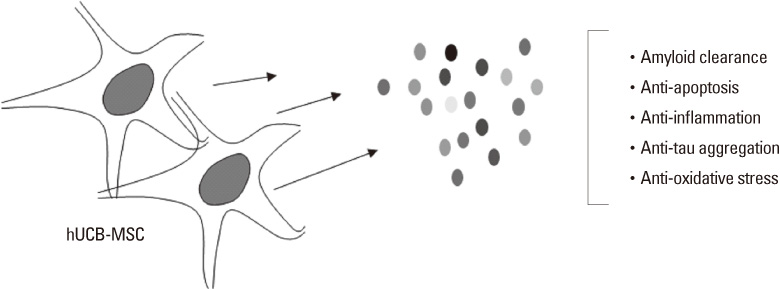Hanyang Med Rev.
2012 Aug;32(3):141-144. 10.7599/hmr.2012.32.3.141.
Recent Trends and Strategies in Stem Cell Therapy for Alzheimer's Disease
- Affiliations
-
- 1Biomedical Research Institute, MEDIPOST Co. Ltd., Seoul, Korea. jwc@medi-post.co.kr
- KMID: 1436763
- DOI: http://doi.org/10.7599/hmr.2012.32.3.141
Abstract
- The human mesenchymal stem cell (MSC) has been regarded as a fascinating candidate of stem cell therapy in neurodegenerative disorders such as Alzheimer disease (AD). Recently, many groups reported that mesenchymal stem cell is a robust source, not only of regeneration, but also of secretion of various soluble factors for damaged or lost host cells. Several groups have observed paracrine action of mesenchymal stem cells in transgenic mice models of AD. From non-clinical studies we can conclude that human mesenchymal stem cells could participate in anti-apoptosis, beta-amyloid removal, anti-inflammation and anti-tau aggregation via paracrine action. Based on these findings, several clinical trials have been performed or completed worldwide. Since safety and efficacy have been confirmed from various non-clinical and clinical trials, we can expect emerging use of stem cells for AD in the near future.
Keyword
MeSH Terms
Figure
Reference
-
1. Vetrivel KS, Thinakaran G. Amyloidogenic processing of beta-amyloid precursor protein in intracellular compartments. Neurology. 2006. 66:S69–S73.
Article2. Jonsson L, Lindgren P, Wimo A, Jonsson B, Winblad B. The cost-effectiveness of donepezil therapy in Swedish patients with Alzheimer's disease: a Markov model. Clin Ther. 1999. 21:1230–1240.
Article3. Carson JA, Turner AJ. Beta-amyloid catabolism: roles for neprilysin (NEP) and other metallopeptidases? J Neurochem. 2002. 81:1–8.
Article4. Miller G. Pharmacology. The puzzling rise and fall of a dark-horse Alzheimer's drug. Science. 2010. 327:1309.
Article5. Querfurth HW, LaFerla FM. Alzheimer's disease. N Engl J Med. 2010. 362:329–344.6. Salem HK, Thiemermann C. Mesenchymal stromal cells: current understanding and clinical status. Stem Cells. 2010. 28:585–596.7. Mitjavila-Garcia MT, Simonin C, Peschanski M. Embryonic stem cells: meeting the needs for cell therapy. Adv Drug Deliv Rev. 2005. 57:1935–1943.
Article8. Kern S, Eichler H, Stoeve J, Kluter H, Bieback K. Comparative analysis of mesenchymal stem cells from bone marrow, umbilical cord blood, or adipose tissue. Stem Cells. 2006. 24:1294–1301.
Article9. Lee RH, Pulin AA, Seo MJ, Kota DJ, Ylostalo J, Larson BL, et al. Intravenous hMSCs improve myocardial infarction in mice because cells embolized in lung are activated to secrete the anti-inflammatory protein TSG-6. Cell Stem Cell. 2009. 5:54–63.
Article10. Parekkadan B, van Poll D, Suganuma K, Carter EA, Berthiaume F, Tilles AW, et al. Mesenchymal stem cell-derived molecules reverse fulminant hepatic failure. PLoS One. 2007. 2:e941.
Article11. Choi YA, Lim J, Kim KM, Acharya B, Cho JY, Bae YC, et al. Secretome analysis of human BMSCs and identification of SMOC1 as an important ECM protein in osteoblast differentiation. J Proteome Res. 2010. 9:2946–2956.
Article12. Ranganath SH, Levy O, Inamdar MS, Karp JM. Harnessing the mesenchymal stem cell secretome for the treatment of cardiovascular disease. Cell Stem Cell. 2012. 10:244–258.
Article13. Nikolic WV, Hou H, Town T, Zhu Y, Giunta B, Sanberg CD, et al. Peripherally administered human umbilical cord blood cells reduce parenchymal and vascular beta-amyloid deposits in Alzheimer mice. Stem Cells Dev. 2008. 17:423–439.
Article14. Lee HJ, Lee JK, Lee H, Carter JE, Chang JW, Oh W, et al. Human umbilical cord blood-derived mesenchymal stem cells improve neuropathology and cognitive impairment in an Alzheimer's disease mouse model through modulation of neuroinflammation. Neurobiol Aging. 2012. 33:588–602.
Article15. Kim JY, Kim DH, Kim DS, Kim JH, Jeong SY, Jeon HB, et al. Galectin-3 secreted by human umbilical cord blood-derived mesenchymal stem cells reduces amyloid-beta42 neurotoxicity in vitro. FEBS Lett. 2010. 584:3601–3608.
Article16. Kim JY, Kim DH, Kim JH, Lee D, Jeon HB, Kwon SJ, et al. Soluble intracellular adhesion molecule-1 secreted by human umbilical cord blood-derived mesenchymal stem cell reduces amyloid-beta plaques. Cell Death Differ. 2012. 19:680–691.
Article17. Blurton-Jones M, Kitazawa M, Martinez-Coria H, Castello NA, Muller FJ, Loring JF, et al. Neural stem cells improve cognition via BDNF in a transgenic model of Alzheimer disease. Proc Natl Acad Sci U S A. 2009. 106:13594–13599.
Article18. Lee JK, Jin HK, Endo S, Schuchman EH, Carter JE, Bae JS. Intracerebral transplantation of bone marrow-derived mesenchymal stem cells reduces amyloid-beta deposition and rescues memory deficits in Alzheimer's disease mice by modulation of immune responses. Stem Cells. 2010. 28:329–343.
Article19. Ostrowitzki S, Deptula D, Thurfjell L, Barkhof F, Bohrmann B, Brooks DJ, et al. Mechanism of amyloid removal in patients with Alzheimer disease treated with gantenerumab. Arch Neurol. 2012. 69:198–207.
Article20. Blennow K, Zetterberg H, Rinne JO, Salloway S, Wei J, Black R, et al. Effect of immunotherapy with bapineuzumab on cerebrospinal fluid biomarker levels in patients with mild to moderate Alzheimer disease. Arch Neurol. Forthcoming 2012.
Article
- Full Text Links
- Actions
-
Cited
- CITED
-
- Close
- Share
- Similar articles
-
- Alzheimer's Disease and Stem Cell Therapy
- Stem Cell Therapy for Neurodegenerative Diseases
- Clinical application of adult stem cell therapy in neurological disorders
- Stem cell therapy for Alzheimer's disease and related disorders: current status and future perspectives
- Gene Therapy and Cell Transplantation for Alzheimer's Disease and Spinal Cord Injury


